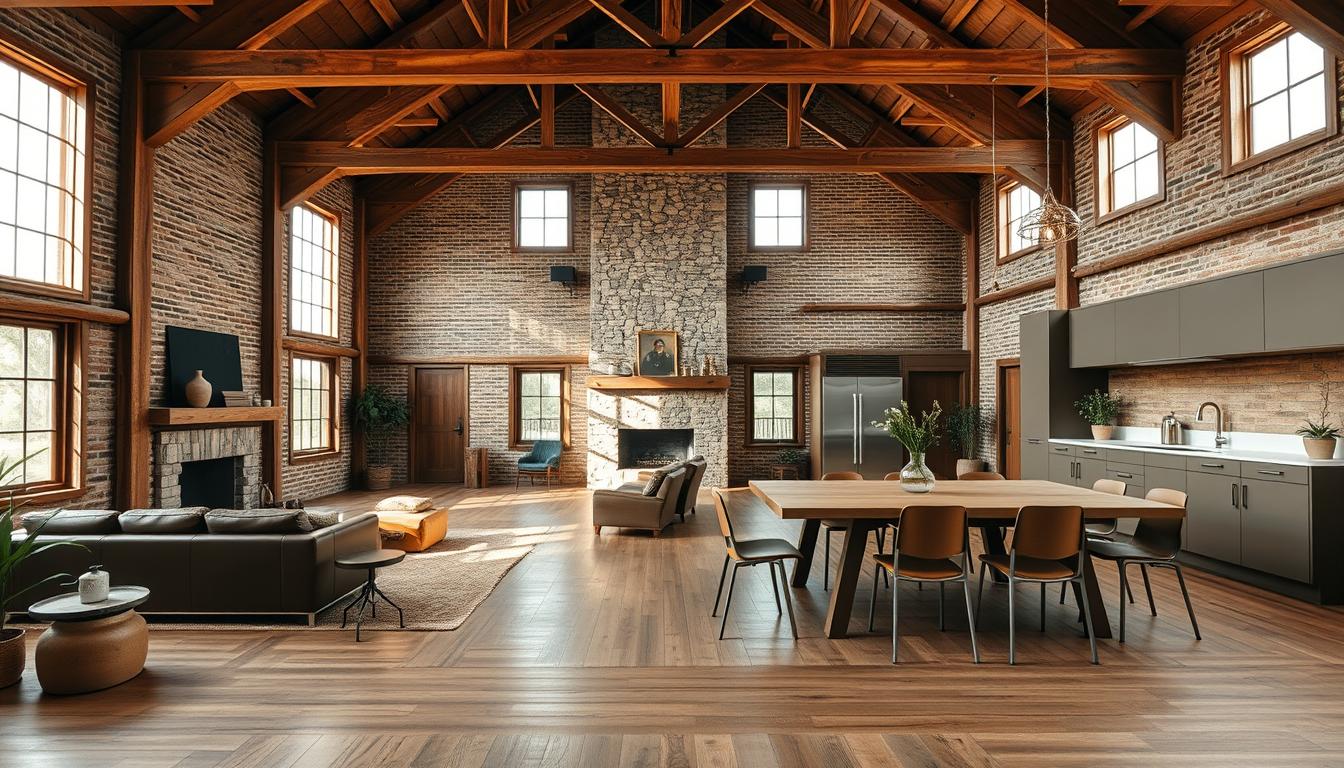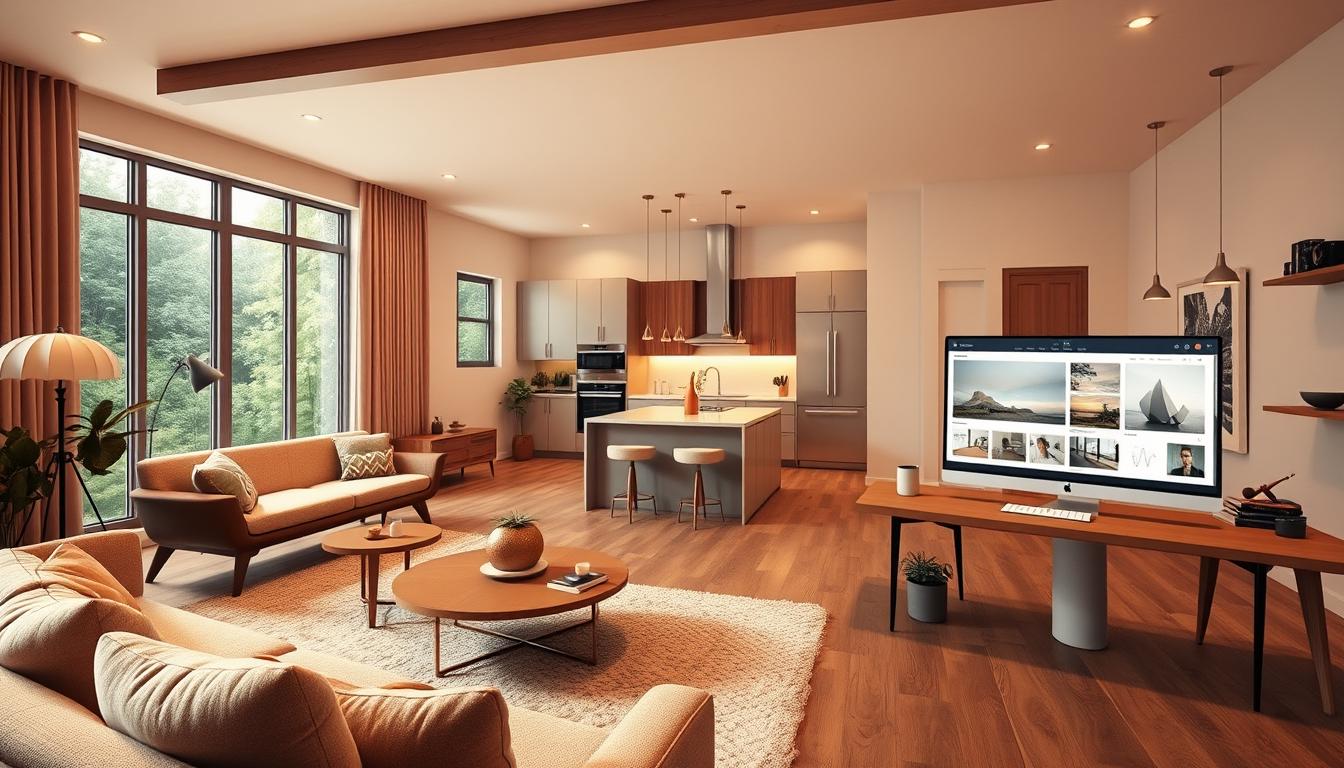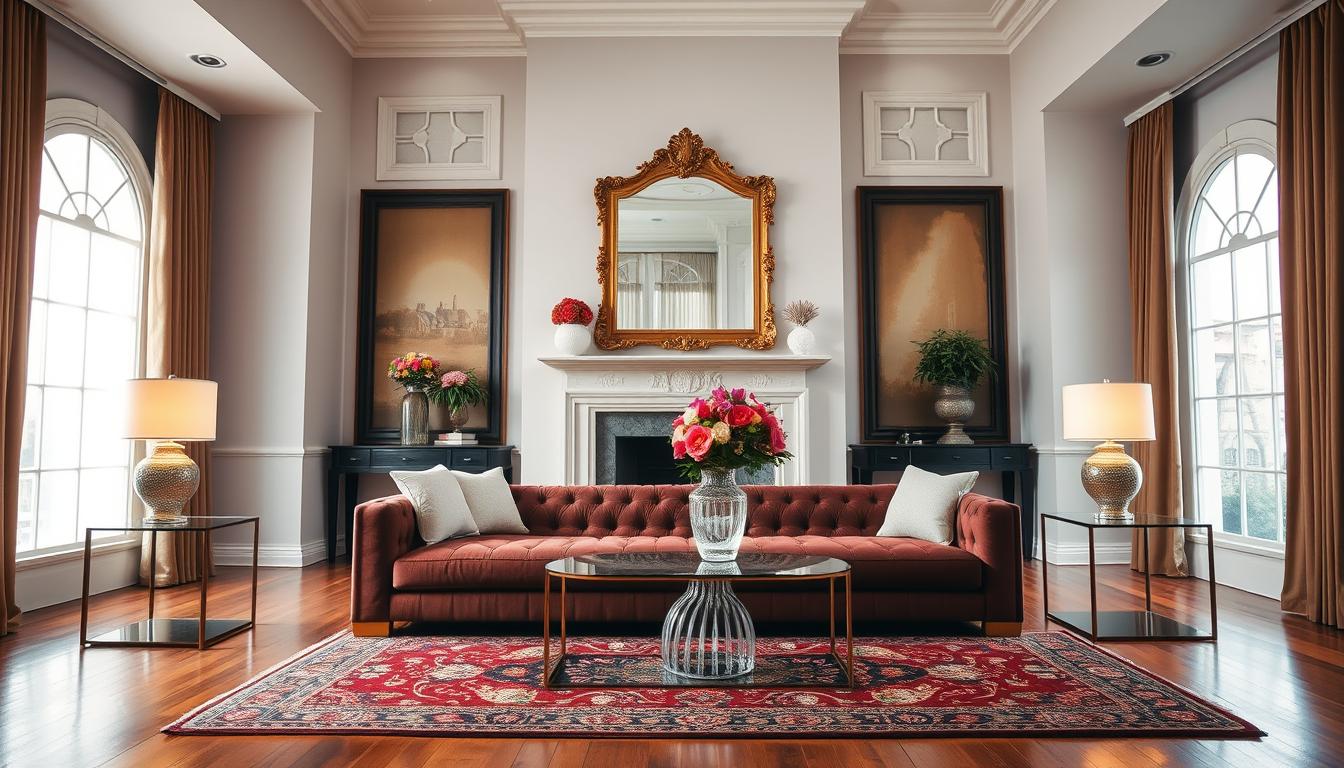Imagine living in a space where old charm meets modern comfort. Converting a barn into a house is a dream for many. It’s a trend growing in popularity across the United States.
These barn renovation ideas keep the barn’s original character. They add modern barn conversion design elements. This creates a unique modern barn house interior.
The original rustic exterior and structural elements are left untouched. They blend well with new rustic barn home decor and comforts. This makes these conversions truly special.
Key Takeaways
- Preserving the original character of the barn is key to a successful conversion.
- Blending rustic elements with modern design creates a unique living space.
- Barn conversions offer a chance to own a piece of history with modern comforts.
- Careful planning is essential to maintain the barn’s original charm.
- Incorporating modern amenities enhances the livability of the space.
The Allure of Barn Conversions
Barn conversions are captivating. They mix rural heritage with modern comforts. These structures let you live in history while enjoying today’s luxuries.
Why People Choose to Live in Barns
Many are drawn to barn conversions. The main reason is the open-space interior they offer. Traditional barns are spacious, perfect for modern, open-plan living areas.
Also, barn conversions let you add rustic barn home decor to your home. You can keep exposed beams and wooden floors. This adds character and warmth.
- Unique architectural features
- Spacious interiors ideal for open-plan living
- Opportunity to preserve historical elements
A Brief History of Barn Conversions
The idea of turning barns into homes started in rural Europe. It was a practical solution for economic reasons. Over time, it became a sought-after lifestyle choice.
In recent years, barn conversions have become popular worldwide. Homeowners want unique spaces that mix history with modernity. This is why barn renovation ideas and barn conversion design are in demand.
Embracing barn living means considering what makes these conversions special. It’s about their spacious interiors and rustic decor.
Planning Your Barn Conversion Project
Turning a barn into a home is more than just fixing it up. It’s about giving a new life to a space with its own story. We must think about several things to make sure our project goes well.
Key Considerations Before You Start
Before starting, we need to check the barn’s condition and what it can become. We should look at its structure, layout, and how we can keep its original charm.
- Check the barn’s foundation and frame for damage or rot.
- Think about how we can change the layout to fit our needs.
- Find out which parts we should keep, like wooden beams or brick walls.
Budgeting for Your Barn Renovation
Planning our budget is key for any renovation. When turning a barn into a house, we must think about costs for materials, labor, and surprises.
| Expense Category | Estimated Cost | Percentage of Total Budget |
|---|---|---|
| Materials | $30,000 | 40% |
| Labor | $25,000 | 33% |
| Permits and Inspections | $5,000 | 7% |
| Contingency Fund | $15,000 | 20% |
As the table shows, having a contingency fund is smart to handle surprises.
Finding the Right Professionals
To make our dream home come true, we need the right team. This includes architects, contractors, and designers who know barn conversions well.
Tips for Selecting Professionals:
- Look for those with barn conversion experience in their portfolio.
- Make sure they have the right certifications and licenses.
- Ask for references and check their past work.
By planning well, budgeting smartly, and choosing the right team, we can create a beautiful and functional home.
Design Ideas for Interior Barns
Barn conversions are more than keeping history alive. They’re about making a modern home that’s both big and cozy. We mix old charm with new design to create something special.
Open Floor Plans: Embracing Space
One big plus of barn conversions is the chance to have open floor plans. By taking down walls, we make the space feel open and airy. It’s ideal for today’s family needs.
Open floor plans also let us design areas that do many things. They can be for living, dining, working, or relaxing. This makes the space feel bigger and brings everyone closer together.
Rustic Elements in Modern Homes
Adding rustic barn home decor to modern homes is key in barn conversions. Keeping things like exposed beams and brick walls keeps the barn’s original feel.
“The beauty of barn conversions lies in their ability to marry the old with the new, creating a unique and captivating living space.”
By mixing rustic touches with modern decor, we get a home that’s both stylish and historic. It’s a perfect blend of old and new.
Incorporating Natural Light
Natural light is essential in barn conversions. Adding windows, skylights, and glass doors makes the space brighter and warmer.
Using natural light cuts down on the need for artificial light. It also shows off the barn’s features like rafters and beams. This makes the home feel welcoming and uplifting.
Essential Renovation Tips
Renovating a barn is a big job. It includes checking the structure, making it more energy-efficient, and picking materials that are good for the planet. We need to keep the old charm while adding new touches.
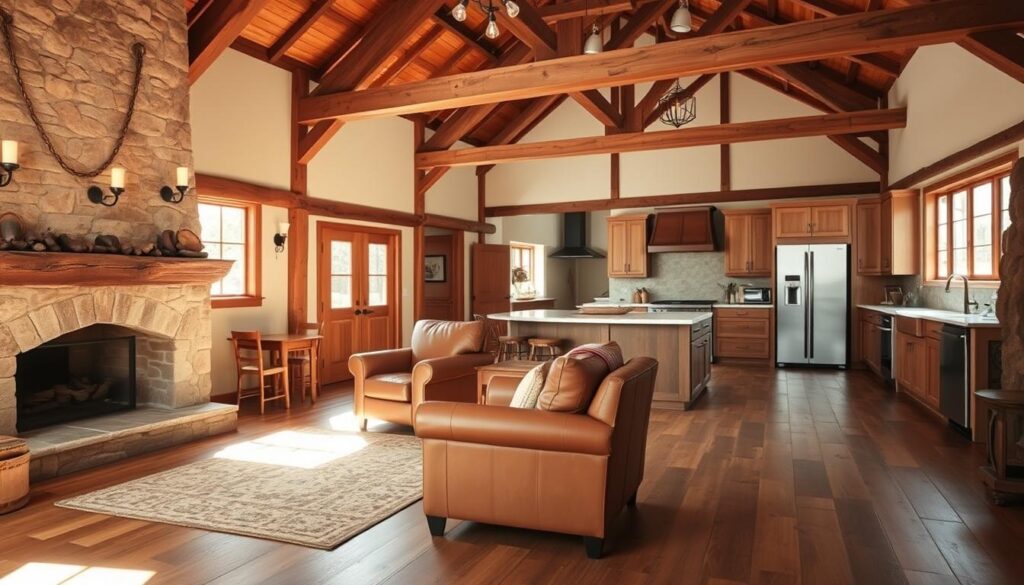
Evaluating Structural Integrity
First, we must check if the barn is strong enough. We look at the foundation, walls, and roof for damage. Getting a pro to check it out can save us money and time.
Barns often have special features like double trusses. These can help us create interesting floors and ceilings. Knowing what we have helps us plan better.
Insulation and Energy Efficiency
Adding insulation and making the barn more energy-efficient is key. We can do this by insulating walls, floors, and ceilings. We also upgrade windows and doors to save energy. Good insulation makes the barn cozy and helps the planet.
- Check the insulation and see where we can improve.
- Use eco-friendly insulation materials.
- Switch to double-glazed windows for better energy use.
Choosing Sustainable Materials
Choosing materials that are good for the planet is important. We use reclaimed wood, low-VOC paints, and local materials. This way, we make our barn home unique and eco-friendly.
“Using reclaimed wood for flooring and walls not only adds character to the barn home but also reduces the demand for new lumber, supporting sustainable forestry practices.”
Some great choices for sustainable materials include:
- Reclaimed wood for floors and walls.
- Bamboo because it grows fast and is renewable.
- Low-VOC paints for better air inside.
Popular Styles of Barn-Centric Interiors
Barn conversions offer a chance to try out various interior styles. This makes it easy to create a space that’s truly yours. Mixing old and new elements is key to a well-designed barn.
The Modern Farmhouse Look
The modern farmhouse style is big in barn conversions. It combines rustic charm with simple functionality. This look often includes exposed beams and reclaimed wood for warmth and character.
To get this style, mix vintage decor with modern appliances. This balance brings together old and new beautifully.
For more ideas on modern farmhouse designs, check out modern barndominium interior design ideas. They highlight important elements for your project.
Industrial Charm in Barn Homes
Industrial charm is another favorite for barn interiors. It features exposed brickwork, metal accents, and open layouts. This style celebrates the barn’s original look while adding modern touches.
To enhance this style, add metal lighting, concrete floors, and simple decor. This creates a sleek, modern feel.
Minimalist Barn Aesthetics
For a calm space, minimalist barn aesthetics are perfect. This style is all about simplicity, using neutral colors and lots of natural light. It’s about keeping things simple to create a peaceful atmosphere.
Minimalist barns have open spaces and large windows. These features connect you to nature and let in plenty of light. It’s great for those who love simplicity and calm.
Creating Functional Spaces
Turning a barn into a home needs careful planning. We must mix rustic charm with modern comfort in our designs. It’s important to use the barn’s unique features to their fullest potential.
Kitchens: The Heart of the Barn Home
The kitchen is the heart of any home, and barn conversions offer a special chance to mix old and new. Use exposed beams and rustic materials to keep the barn’s charm. Then, add modern appliances and sleek countertops for a modern look.
For kitchen design ideas, check out barn remodel inspiration online. You’ll find great examples of combining old and new.
Designing Cozy Living Areas
Living areas in barn conversions are perfect for cozy, inviting spaces. Use warm lighting and comfortable furnishings to make it welcoming. Adding natural elements like stone or wood enhances the rustic feel.
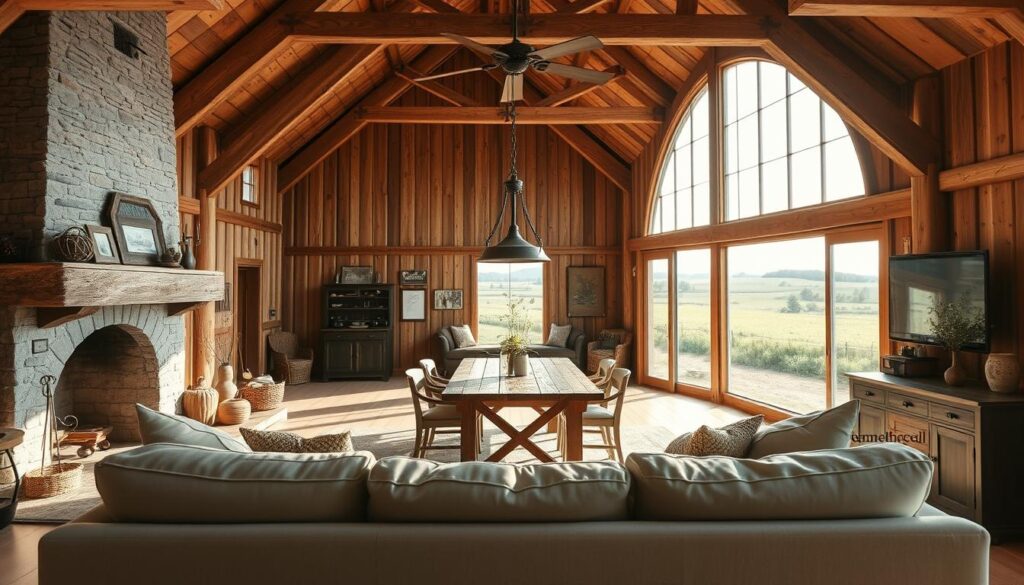
Think about the space’s flow and how it connects to other areas. Open floor plans work well in barn conversions. They make the space feel open and connected.
Bedrooms: Blending Comfort and Style
Bedrooms in barn conversions should be peaceful and stylish. Use soft textiles and calming colors for a serene feel. Reclaimed wood or natural materials add warmth and character.
Good interior design for barn homes balances old and new. This way, the spaces are not just beautiful but also functional and cozy. By designing each room carefully, you create a home that honors the barn’s history and offers modern comfort.
Outdoor Spaces and Barn Living
Outdoor areas in barn conversions mix rustic charm with modern living. They create welcoming spaces that match our barn homes. Unlike traditional houses, barns offer views in every direction, making the outdoors a key part of our lives.
Designing Inviting Outdoor Areas
When designing outdoor spaces for barn living, think about the natural surroundings. Rustic barn home decor can extend to outdoor areas with natural materials. This includes patios, walkways, and furniture.
Creating inviting outdoor areas is more than just adding furniture. It’s about making a space that matches the barn’s architecture. We can do this with stone fireplaces, outdoor kitchens, and lush landscaping that shows off the countryside’s beauty.
Utilizing Bobcats and Barns in Landscaping
Landscaping around a barn conversion needs careful planning. It must keep the rustic charm while being functional. Using heavy machinery like bobcats helps in reshaping the landscape. This can include terraces or even a pond that fits the barn’s natural setting.
To blend the barn into the landscaping, use native plants and keep natural features. Make sure new additions, like pathways or outdoor lighting, match the barn’s design.
By designing our outdoor spaces well and blending the barn into the landscaping, we improve our barn living space. This creates a perfect mix of indoor and outdoor living areas.
Real-Life Barn Home Transformations
Looking to turn a barn into your dream home? There are many examples to inspire and guide you. Barn conversions mix rustic charm with modern luxury, making them a popular choice for home renovation.
Case Studies of Successful Conversions
One standout example is a barn on Lord Astor’s model farm in Cliveden. George Evans of Strutt & Parker calls it one of the most beautiful conversions he’s seen. It shows how barns can become stunning homes, keeping their original charm but with modern comforts.
Other examples show the need for careful planning and design. For example, a countryside barn might become a large open-plan living area. It will have exposed beams and rustic stone walls, alongside modern kitchens and bathrooms.
Lessons Learned from Homeowners
Homeowners who’ve converted barns share valuable lessons. One key point is the importance of being flexible during the renovation. You might face unexpected issues like structural damage or local building rules. Being ready to adjust your plans is essential.
Another important lesson is the benefit of working with experienced professionals. Architects, builders, and designers familiar with barn conversions can help avoid costly mistakes. They ensure your vision is brought to life.
By looking at these examples and lessons, you can better understand the process of turning a barn into a beautiful home. It’s a journey filled with challenges and rewards.
Permits and Regulations for Barn Conversions
Starting a barn conversion project means getting to know local rules. It’s not just about fixing up an old building. You also need to follow legal and safety standards.
Understanding Building Codes
Building codes are key to making sure your barn conversion is safe. They cover things like how strong the structure is, fire safety, and energy use. Knowing the building codes for your area is crucial when converting a barn into a house.
To follow building codes, you should:
- Get advice from local building officials on what’s needed.
- Work with experts who know the local codes well.
- Make sure every part of the conversion, from wiring to insulation, meets or goes beyond code.
Navigating Zoning Laws
Zoning laws tell you how you can use your property, including what changes you can make. Knowing these laws is key for a barn remodel inspiration project to avoid legal trouble.
| Aspect | Description | Considerations |
|---|---|---|
| Zoning Classification | Tells if your barn can be turned into a home. | Check with local zoning officials. |
| Permitted Uses | Lists what you can use the property for after changing it. | Make sure your plans fit with local rules. |
| Setback Requirements | Shows the minimum distance from the barn to property lines or other buildings. | Plan your changes to meet these rules. |
For interior design for barn homes, being creative is great. But, you must also follow these rules. This way, your home will be both beautiful and legal.
By following building codes and zoning laws, you can turn a barn into a unique and useful home. You’ll mix old charm with new features while keeping the original’s spirit.
Maintaining Your Barn Home
To keep your barn home in top shape, a proactive maintenance plan is key. Barns are great for living, but they need regular upkeep.
Tips for Long-Term Care
For long-term care, focus on the building’s structure. Make sure the foundation, walls, and roof are sound.
Regular inspections are vital. Look for cracks in walls or leaks in the roof and fix them quickly.
- Inspect the roof for damaged or missing tiles.
- Check the walls for cracks or signs of water damage.
- Ensure that the foundation remains stable.
Keeping your barn home sustainable is also crucial. Use eco-friendly materials for repairs and install energy-efficient systems.
Seasonal Maintenance Checklists
Seasonal maintenance is key to avoid weather-related problems. Here’s a simple checklist to start with:
| Season | Tasks |
|---|---|
| Spring | Inspect gutters, clean out debris, check for pest infestations. |
| Summer | Check for signs of heat damage, maintain outdoor spaces. |
| Autumn | Prepare for winter by insulating pipes, checking the roof for leaves. |
| Winter | Monitor for ice dams, keep gutters clear, check for drafts. |
By following these tips and checklists, we can keep our barn home cozy and eco-friendly. Remember, the secret to successful barn living is regular maintenance and preserving its charm.
The Future of Barn Conversions
Barn conversions are changing with new lifestyles and tech. They keep their value well, making renovations today better than 30 years ago.
Emerging Trends
Now, barn homes focus more on being green and saving energy. People use eco-friendly materials and methods. This fits with the bigger trend of living sustainably.
Eco-Friendly Barn Living
Turning barns into homes is not just about looks. It’s also about living green. By using old barns, we cut down on new building’s harm. As more want green homes, barn conversions will stay popular.
